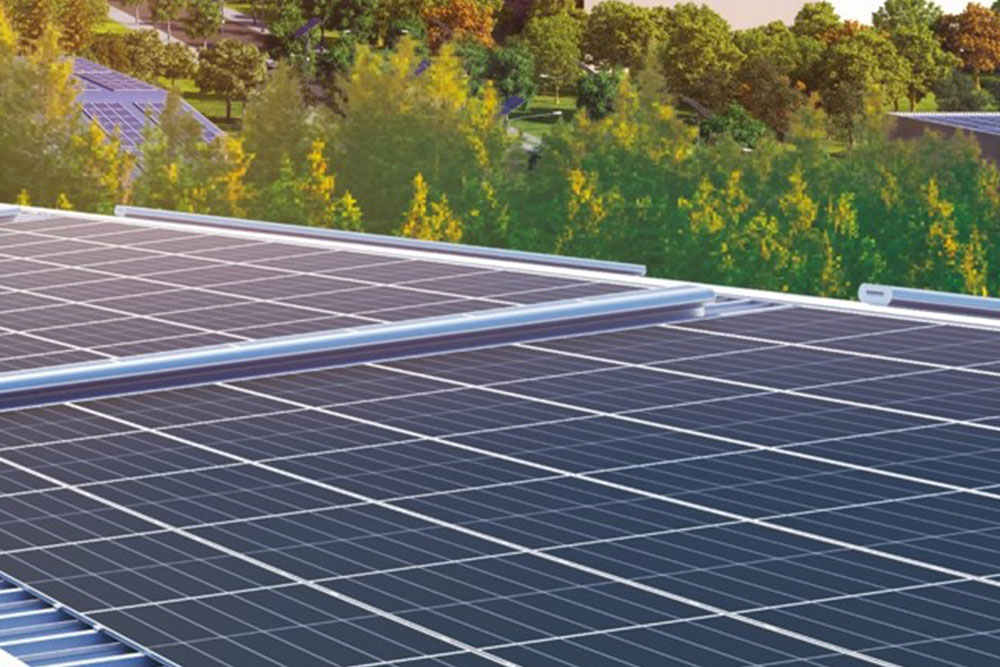光伏發電原理
光伏發電的原理主要基于半導體界面的光生伏特效應,這是一種將光能直接轉變為電能的技術。以下是對光伏發電原理的詳細解釋:
The principle of photovoltaic power generation is mainly based on the photovoltaic effect of semiconductor interfaces, which is a technology that directly converts light energy into electrical energy. The following is a detailed explanation of the principle of photovoltaic power generation:
一、光生伏特效應
1、 Photovoltaic effect
光生伏特效應是光伏發電的基本原理。當太陽光照射在半導體材料(如硅)上時,光子會與半導體的原子發生相互作用。這個過程中,光子將能量傳遞給半導體中的電子,使其獲得足夠的能量從原子中逸出,形成自由電子和空穴。自由電子和空穴在半導體內部形成電場,從而產生電勢差。當外部電路接通時,電子在電場的作用下定向移動,形成電流,從而將太陽能轉換為電能。
The photovoltaic effect is the fundamental principle of photovoltaic power generation. When sunlight shines on semiconductor materials such as silicon, photons interact with the atoms of the semiconductor. During this process, photons transfer energy to electrons in the semiconductor, allowing them to gain enough energy to escape from the atoms and form free electrons and holes. Free electrons and holes form an electric field inside the semiconductor, resulting in a potential difference. When an external circuit is connected, electrons move in a directional manner under the action of an electric field, forming an electric current, thereby converting solar energy into electrical energy.
二、太陽能電池的工作原理
2、 The working principle of solar cells
太陽能電池是實現光伏發電的核心部件。太陽能電池通常由P型半導體和N型半導體組成,當它們結合在一起時,會在接觸面形成電勢差,即PN結。當太陽光照射到PN結上時,光子激發半導體中的電子,使其從價帶躍遷到導帶,形成自由電子和空穴。在PN結內建電場的作用下,空穴由P極區往N極區移動,電子由N極區向P極區移動,形成電流。這個電流就是太陽能電池產生的電能。
Solar cells are the core components for achieving photovoltaic power generation. Solar cells are typically composed of P-type and N-type semiconductors, which when combined, form a potential difference at the contact surface, known as a PN junction. When sunlight shines on the PN junction, photons excite electrons in the semiconductor, causing them to transition from the valence band to the conduction band, forming free electrons and holes. Under the action of the built-in electric field in the PN junction, holes move from the P region to the N region, and electrons move from the N region to the P region, forming a current. This current is the electrical energy generated by solar cells.
三、光伏發電系統的組成
3、 Composition of Photovoltaic Power Generation System
光伏發電系統通常由太陽能電池板、控制器、逆變器等主要部件組成。太陽能電池板是系統的核心,其主要功能是將光能轉換為電能。控制器用于控制太陽能電池板的輸出電壓和電流,以保證系統穩定運行。逆變器的作用是將直流電轉換為交流電,以滿足各類設備的用電需求。
Photovoltaic power generation systems are usually composed of main components such as solar panels, controllers, inverters, etc. The solar panel is the core of the system, and its main function is to convert light energy into electrical energy. The controller is used to control the output voltage and current of the solar panel to ensure stable operation of the system. The function of an inverter is to convert direct current into alternating current to meet the electricity needs of various devices.
四、光伏發電系統的分類
4、 Classification of Photovoltaic Power Generation Systems
光伏發電系統可以分為離網光伏系統和并網光伏系統。
Photovoltaic power generation systems can be divided into off grid photovoltaic systems and grid connected photovoltaic systems.
離網光伏系統:不依賴于公共電網,可以為遠離電網或無法接入電網的用戶提供電能。獨立光伏系統主要由太陽能電池組件、控制器、蓄電池等組成。
Off grid photovoltaic system: It does not rely on the public power grid and can provide electricity to users who are far away from the grid or unable to connect to the grid. The independent photovoltaic system mainly consists of solar cell modules, controllers, batteries, etc.
并網光伏系統:太陽能電池產生的直流電經過并網逆變器轉換成符合市電電網要求的交流電之后,直接接入公共電網。并網光伏發電系統可以分為帶蓄電池的和不帶蓄電池的并網發電系統。
Grid connected photovoltaic system: The direct current generated by solar cells is converted into alternating current that meets the requirements of the municipal power grid through a grid connected inverter, and then directly connected to the public power grid. Grid connected photovoltaic power generation systems can be divided into those with batteries and those without batteries.
綜上所述,光伏發電是一種利用半導體界面的光生伏特效應將光能直接轉變為電能的技術。通過太陽能電池板、控制器和逆變器等部件的協同工作,光伏發電系統可以將太陽能轉換為電能,為各種設備提供電力支持。
In summary, photovoltaic power generation is a technology that utilizes the photovoltaic effect of semiconductor interfaces to directly convert light energy into electrical energy. Through the collaborative work of components such as solar panels, controllers, and inverters, photovoltaic power generation systems can convert solar energy into electrical energy, providing power support for various devices.
本文由 天合光能 友情奉獻.更多有關的知識請點擊 http://www.51dwgw.cn 真誠的態度.為您提供為全面的服務.更多有關的知識我們將會陸續向大家奉獻.敬請期待.
This article is a friendly contribution from Trina Solar For more related knowledge, please click http://www.51dwgw.cn Sincere attitude To provide you with comprehensive services We will gradually contribute more relevant knowledge to everyone Coming soon.
新聞推薦
product recommendation聯系方式
Contact Information

 TEL:0531-82390078
TEL:0531-82390078 TEL:18805312017
TEL:18805312017 MAI:sdzdny001@163.com
MAI:sdzdny001@163.com 公司地址: 濟南市歷下區山大路157號
公司地址: 濟南市歷下區山大路157號 天合藍天·山東種電
天合藍天·山東種電 備案號:魯ICP備17052940號-2
魯公網安備37010202700164號
備案號:魯ICP備17052940號-2
魯公網安備37010202700164號
 網站地圖|XML|TXT
網站地圖|XML|TXT

掃一掃方便咨詢我們

截屏,微信識別二維碼
微信號:18805312017